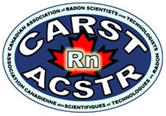 Canadian Association of Radon Scientists and Technologists Helping Canadians Reduce Radon Risk |
Things to Consider When Buying a Home
A recent Health Canada survey revealed that 7% of Canadians are living in homes with high radon levels. While all homes have some level of radon, the consideration that needs to be made when considering a purchase is how likely it is that the radon level is high, and how much it will cost to fix.
Radon enters a building through contact with the ground.
Here are a few examples:
- unfinished dirt or gravel floors
- construction joints (joints in the concrete)
- gaps around service pipes
- open sump pits
- openings in the foundation
If you've fallen in love with your dream home; it's important to know that all homes can have their radon levels reduced. You can move into your home and test for radon during the first heating season that you occupy the house. After a long-term radon test is completed, you will know what the radon level is and whether or not it needs to be reduced.
If you aren't sure you want to purchase a test without some indication of the radon level, CARST has developed a guideline for conducting a Radon Screening Assessment to give you an indication of how likely it is that a home has elevated radon levels.
Understanding a Radon Assessment During a Real Estate Transaction
First, contact a C-NRPP Measurement Professional to conduct a Radon Screening Assessment for you.
The occupant of the home must agree to the test, and also to keeping the home under 'closed house' conditions for as long as required.
Closed-house conditions include:
- Windows should stay closed at all times,
- External doors opened only for entry and exit,
- Attached garage doors should be opened only for entry and exit,
- Fireplaces should not be operated during the radon test, unless they are the primary heat source.
- Clothes dryer, range hood, and bathroom fan operation should be limited to the minimum necessary,
- Radon mitigation systems shall be operated as normal.
- Heat-Recovery Ventilator (HRV) and Energy Recovery Ventilator (ERV) shall be left to operate (or not operate) as found. For example, if an HRV is plugged in and working it should be left working, if unplugged, should be left unplugged.
The Radon Screening Assessment will be set up by the C-NRPP Measurement Professional. The detector must be in place for a minimum of 4 days. A longer duration is preferred, but not always practical in a real estate situation.
Understanding my Radon Assessment Report
Do I Need to Worry About Newly Built Homes?Green Test Result
A Green Test Result indicates a radon screening assessment of 75 Bq/m3 or less during the heating season and 50 Bq/m3 or less outside the heating season. It is important to note that a “Green” test does not guarantee that the annual average radon concentration in the dwelling is below 200 Bq/m3. A long-term follow-up radon measurement conducted during the next heating season must still be carried out.
Yellow Test Result
A Yellow Test Result indicates a radon screening assessment of greater than 75 Bq/m3 during the heating season or 50 Bq/m3 outside the heating season, up to and including 400 Bq/m3. This result indicates that there is a higher likelihood that the annual average radon concentration is above 200 Bq/m3.
Red Test Result
A Red Test Result indicates a radon screening assessment of greater than 400 Bq/m3. This result indicates a strong likelihood that the annual average radon concentration is above 200 Bq/m3.